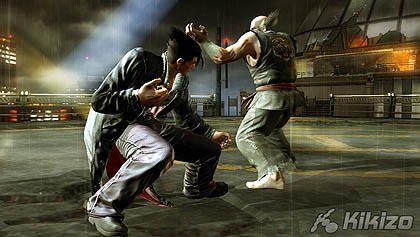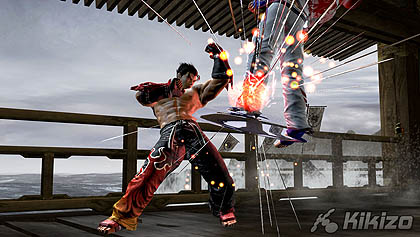Interview: Tekken 6: Bloodline Rebellion
Tekken boss Katsuhiro Harada talks to us in detail about the latest addition to the series, first details on the console versions, Tekken versus other fighting games, leaving PlayStation exclusivity, and the future of Tekken.

Having recently brought you literally the only interview with Sega Japan on its latest Virtua Fighter title, VF5R, today we're pleased to present this sit down with Namco Bandai's top man of all things Tekken, Katsuhiro Harada, for the first detailed interview on the latest in his own popular series: Tekken 6: Bloodline Rebellion.
It's not going to hit consoles for quite a while yet - fall next year, we're told - but there's going to be a lot packed into the title. There'll be 40 combatants available, which is eight more on top of Tekken 5, and the most the series has ever crammed into one title. For Tekken 6, four new characters were added, on top of Dark Resurrection's new duo.
Bloodline Rebellion, which is released in Japanese arcades on December 18 (and happens to be the version next year's PS3 and Xbox 360 release is based on) adds a further two characters - Alisa Boskonovitch and Lars Alexandersson - both sounding like they're straight off the set of a European porn flick, and both looking the part as well. A final bonus character, Azazel, is said to bring the true roster up to 41 characters overall.
Harada-san is the Manager of Game Design Section 2, R&D Dept. 1, R&D Div. 1 at the Contents Production Headquarters of Namco Bandai Games Inc., which is quite a mouthful but basically means it's Namco's elite studio and this is the guy who's been in charge of Tekken for over ten years. He showed us the arcade version of the game that's due out in Japan next week, and demonstrated it to us using a rather cute little console-style arcade stick.
Kikizo: How much would you say you're designing Tekken 6 for the Japanese arcade scene, which is still really competitive, compared to console players around the world?
Harada: It's a difficult question, but I have been working on the series myself for over ten years now, and I have really tried to tune the emphasis so that it does well in both the arcades and at home. Probably the console users are ten or twenty times more than the arcade, so there is that fact, but I have tried to focus on making a game that appeals to both - it's not made for just the hardcore arcade audiences. It's pretty well balanced, and it kind of shows, because it still has popularity in arcades. Maybe one of the key factors is that even if you have a very bad player against someone who's not so bad, if you play ten matches, the advanced player won't always win all ten of those, that is just the nature of the game to mix things up a bit.
One thing that having an arcade version has allowed us to do, especially in Japan, is that once the game's released, it's online, it's networked, so we can get a lot of feedback and then adjust the game - we can update it over the network, so that has allowed us to do a lot of balancing of the game and the fighters, which is very difficult to do. And since we still have a while to go before the release of the console version, that feedback will not only strengthen the arcade version but also it will mean a more balanced console game.
Kikizo: You remember close to the beginning of the series, a time when Tekken was very closely associated with PlayStation. Obviously it's not just PlayStation now, so what would you say the sort of die-hard PlayStation fans who maybe feel 'betrayed'?
Harada: Yes, we have developed it PlayStation 1, 2 and now 3, so it is true that we have really grown with the PlayStation brand - we have a lot of fond memories, and we worked very closely with Mr Kutaragi as well, so we had a really good relationship. We love the platform. But rather than some fans feeling disappointed, there are a lot of Xbox users out there at the moment, and a great deal of fans who only have an Xbox and really want to play Tekken, which is the number one in the fighting genre. And we just had so many fans that said "we really want to get our hands on it, but can't." So we wanted to answer those fans. And it's also the timing at this point - at the moment we have two high spec consoles on the market at the same time; the Xbox has a huge installed base in Europe and America. So it was more about trying to answer the fans' requests and having as many as possible be able to get the game - that was the objective there.
Kikizo: I think the first time you showed the game was back at E3 2005 when they showed PlayStation 3 for the first time, as just a CG teaser. Subsequent to that, the very first in-game shots you released were disappointing; however, we now see that the game is much improved since then. Can you talk us through these development phases?
Harada: First off, when we released that footage, well we weren't really working on the title so much at that time. We had Tekken Dark Resurrection going on at that point, but we hadn't really had much hands on time with PS3, at all. And where other developers have had kind of pre-rendered stuff that they were showing off on the PS3, we were one of the times who had real-time footage from the console itself. [Note: He is obviously referring to the E3 2006 video, here rather than the initial E3 2005 teaser, which in fairness was labelled simply "Tekken"].
So in that regard, it was kind of hard to show off the power at that point. And so then the next step in the process was Tekken 6, which was released in arcades about a year ago now. We'd had more time with the PS3, in the form of the PS3-based architecture of the arcade board. But we still weren't really satisfied with the result at that point with Tekken 6. So then we came to develop an expansion for that, Bloodline Rebellion, which is scheduled to hit arcades later this month. One of the new things we were able to do is that while the game is still running at 60 frames, which it always has, we've added a lot more post-processing effects, for example the motion blur and such. So the graphical quality has increased dramatically since then. And actually, the [Soul] Calibur team and even the [Sega] Virtua Fighter team, have had their eyes on motion blur technology, but they've kind of given up on trying to implement that while maintaining 60 frames. So that's something new that we've accomplished this time with Tekken. I would say after working on Tekken games for ten years, this is really a great improvement.








 Satoru Iwata Video Interview - the late Nintendo president spoke with Kikizo in 2004 as 'Nintendo Revolution' loomed.
Satoru Iwata Video Interview - the late Nintendo president spoke with Kikizo in 2004 as 'Nintendo Revolution' loomed. Kaz Hirai Video Interview - the first of Kikizo's interviews with the man who went on to become global head of Sony.
Kaz Hirai Video Interview - the first of Kikizo's interviews with the man who went on to become global head of Sony. Ed Fries Video Interview - one of Xbox's founders discusses an epic journey from Excel to Xbox.
Ed Fries Video Interview - one of Xbox's founders discusses an epic journey from Excel to Xbox. Yu Suzuki, the Kikizo Interview - we spend time with one of gaming's most revered creators.
Yu Suzuki, the Kikizo Interview - we spend time with one of gaming's most revered creators. Tetris - The Making of an Icon: Alexey Pajitnov and Henk Rogers reveal the fascinating story behind Tetris
Tetris - The Making of an Icon: Alexey Pajitnov and Henk Rogers reveal the fascinating story behind Tetris Rare founders, Chris and Tim Stamper - their only interview? Genuinely 'rare' sit down with founders of the legendary studio.
Rare founders, Chris and Tim Stamper - their only interview? Genuinely 'rare' sit down with founders of the legendary studio. The History of First-Person Shooters - a retrospective, from Maze War to Modern Warfare
The History of First-Person Shooters - a retrospective, from Maze War to Modern Warfare